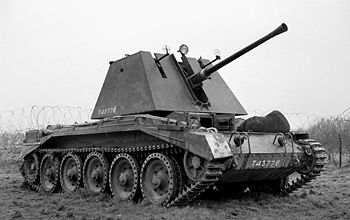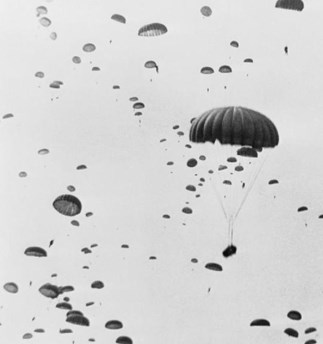Weapons in Brief: The Alphabet Goes to War
The War Illustrated, Volume 8, No. 192, Page 374, October 27, 1944.
Communiqués and newspapers refer frequently to Service arms, weapons, secret and otherwise, ships and personnel, by initial letters and names which sometimes can be very puzzling to the reader. This craze for contraction is founded on good reason, for full titles can be cumbersome. These labels – some familiar, some strange – are explained by JOHN FLEETWOOD.
The first craft to reach Normandy beaches with their spearhead freights were L.C.V.P.s (Landing Craft – Vehicles and Personnel), littlish fellows carried slung from the davits of troopships. The transports lowered their "babies" and, nose to tail, the little craft circled the mother ship, waiting for their crews to board them.
A few thousand yards offshore two patrol ships rode the swell, almost motionless. A mile or so apart, they marked the starting line just beyond the range of effective machine-gun fire. On these ships each wave of landing craft "dressed" like a battalion of infantry, then off they careered for the beaches. As each wave went in a new group of L.C.s advanced to the starting line, and when their turn came they went in too.
Most of the men moved off to find and fight the enemy, destroy his guns, push him back from the beach. A few stayed at the water's edge to signal in the landing craft and regulate the flow of supplies. These were the beach commander and his staff – no kin with the duckmaster of the DUKWS (the factory serial letters for D the boat, U the lorry body, KW the lorry chassis), but a mixed team of soldiers and seamen, whose duties are to see that each specialized section, either of personnel or stores, finds, as it lands, its right place in the beach area.
Back with the bigger ships were larger landing vessels – L.C.I.s (Landing Craft – Infantry), some of the biggest of landing craft, with two disembarking ramps, one on either side of the bows; and L.S.T.s (Landing Ship – Tank). Both of these are ocean-going vessels which move under their own power. An L.C.I. is 155 feet long; when she hits the shore, down go the twin ramps, and over 200 pour out on to the beach.
An L.S.T. is larger still; she is, in fact, a floating garage with vehicles clamped to her lower deck by heavy chains against the formidable roll these ships develop when on the move. Once beached, her mouth opens and trucks and vehicles of every description roll out of her; others are lifted by davits from her hold. By the time these ships go in, the landing is well under way, and their mobile freights quickly build up the power of the assault. In contrast with these large craft are the diminutive L.B.K.s (Landing Barge – Kitchen), baking bread and providing hot meals for the men who ferry supplies (see story and illus. in page 251).
It is a queer-looking family, this vast and varied breed of invasion craft. For one class – L.C.F.s (Landing Craft – Flak) – invasion found little work to do, the Allied Air Forces having had from the outset complete mastery of the air. And do you remember L.C.A.s (Landing Craft – Assault), the old originals, from which the men leaped straight over the bows, and whose proper duties were reversed to evacuate out troops from Norway and Dunkirk? When the time came to employ them for the role in which they were cast, the L.C. family had been varied and expanded a hundredfold. Latest in the list is the L.C.T.R. (Landing Craft Tank – Rocket). Everybody knows the M.T.B.s (motor-torpedo-boats), but the P.T.s are less familiar. P.T.s are American M.T.B.s, and America's "plywood navy" is giving a good account of itself.
 Crusader Bofors A.A. tank, in operation against the enemy in Europe, is a development of the Bofors 40-mm. S.P. (self-propelled) gun mentioned in this page. Designed primarily for the protection of convoys on the move against low-flying aircraft, it fires 2-lb. shells at the rate of 120 per minute. Photo, British Official.
Crusader Bofors A.A. tank, in operation against the enemy in Europe, is a development of the Bofors 40-mm. S.P. (self-propelled) gun mentioned in this page. Designed primarily for the protection of convoys on the move against low-flying aircraft, it fires 2-lb. shells at the rate of 120 per minute. Photo, British Official.
Normandy beaches are a glorious page of past history, but it is not too late to pay tribute to the N.B.S.O. (Naval Bomb Safety Officer), who with his Naval and Marine colleagues has immunized hundreds of mines in the sea and on beaches since D-Day. Few serving men were more symbolic of the spirit of Britain during the long dark years of the U-boat and Luftwaffe peril than the M.R.A. At one period in action almost every day and night of the year, more than 7,000 gunners of the Maritime Royal Artillery, spread over the seven seas in ships of the Merchant Navy, were constantly on the alert for aircraft, U-boats and surface raiders. Dubbed "Churchill's Sharpshooters" because they were formed at the instance of the Prime Minister himself, these artillerymen on loan to the Navy can operate 20 different kinds of guns, and other defensive weapons.
Speaking of gunnery, one of the best things that ever came out of our gun laboratories is the Projector, Infantry, Anti-Tank – P.I.A.T. for short – which fires a bomb that will pierce four inches of the sturdiest armour-plate and inflict serious damage on the interior of tanks, often killing the crew.
When is a gun self-propelled? When it is mounted on either a truck or tractor so that it can be fired without dismounting or unlimbering. The Bofors 40-mm. S.P., long a mainstay of Britain's A.A. defences, is a prime example of the guns of the self-propelled class. It is power-elevated and traversed, and fires 2-lb. shells to a height of 6,000 feet at 120 a minute. The Morris chassis, or modified version of the artillery Quad (tractor), on which it is mounted, gives the Bofors a maximum road speed of 40 m.p.h., rendering in one of our fastest mobile weapons and an invaluable protection for convoys en route.
Most mobile of all are machine-guns, especially those of the L.M.G. (Light Machine-Gun) class – the Lewis, Bren and the machine carbine, the Sten. But the Heavies run them very close for mobility, since the Vickers and its like are nowadays carried as nearly as possible into action on wheeled transport. To the tank family there has recently been added the A.V.R.E. (Armoured Vehicle, Royal Engineers), the new British mortar tank.
Those responsible for inspecting the ammunition eaten up in such enormous quantities by today's swift-firing guns are persons of vast technical experience, yet the work is being increasingly done by the A.T.S. Ten A.E.s (Ammunition Examiners) of the A.T.S. at one depot alone inspect and supervise the repair, examination and packing of tons of live ammunition every week, working in isolated groups in dispersed sheds.
Girls of one of the manifold branches of work now handled by the A.T.S. are known in the Army, and outside it, as O.W.L.s, though the girls themselves are not smitten with the name. However, the soubriquet was chosen; it just happened, for the letters mean Operators, Wireless and Line, these Signal girls serving as "linemen" as well as radio operators.
In other spheres there are the P.O.L. units of the R.A.S.C., the men who handle the unshipping and distribution of the lifeblood of modern battle – Petrol, Oil and Lubricants; and the F.S.U.s – the Field Surgical Units of the R.A.M.C., whose duties take them close up behind the front line so that they may operate on casualties from one to six hours after injury.
Communiqués on air activities talk of Emergency Landing Grounds as E.L.G.s. D.E.O.P.s. are supplies dropped from aircraft without a parachute attached. The Special Force referred to in S.E.A.C. (South East Asia Command) communiqués are the Chindits formed by General Wingate. Many of these dispatches allude to Japanese Bunkers. These vary in size from a one-man foxhole with a lid, to a section bunker accommodating from six to 26 men, well provisioned with food and ammunition, and equipped with sleeping bays, cooking quarters and latrines.
Sometimes a cryptic military term must preserve its mystery, unchallenged. The L.C.O.C.U., for instance, is still on the secret list. A weapon lately released from it is the M1-A1, a new type of American "flame-gun", a fearful weapon, as the enemy has learned to his cost. M1-A1 is far superior to anything so far used by the foe, and the intense, all-enveloping liquid fire-power it develops seems largely to have solved the riddle of breaking down the Nazi-developed pillbox defence in depth, without the frequently futile, and far more costly, expenditure of high explosives. An illustrated description of Britain's flame-throwers is given in pages 300 and 301.
Index
Previous article
British Valour in the Hell that was Arnhem
In hundreds the parachute troops of the 1st Airborne Army were dropped in landing areas from transport planes (1). Some, hard-pressed in their foxholes at Arnhem, bombarded German positions with thr
Next article
I Was There! - It Was a 'Tough Do' at the Bridge of Arnhem
A handful of British parachute troops who fought on for three days and nights when surrounded at the end of the Arnhem bridge were taken prisoner, removed to Germany, then escaped to our lines. One of




